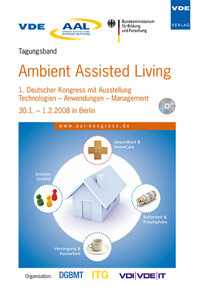ICT-supported community medicine nurse: Bringing primary health care to the patients' home
Konferenz: Ambient Assisted Living - AAL - 1. Deutscher AAL-Kongress mit Ausstellung / Technologien - Anwendungen - Management
30.01.2008 - 01.02.2008 in Berlin, Germany
Tagungsband: Ambient Assisted Living - AAL
Seiten: 4Sprache: EnglischTyp: PDF
Persönliche VDE-Mitglieder erhalten auf diesen Artikel 10% Rabatt
Autoren:
Karopka, Thomas; Bruder, Ilvio (IT Science Center Rügen gGmbH, Putbus, Germany)
Berg, Neeltje van den; Hoffmann, Wolfgang (Institute for Community Medicine, University of Greifswald, Germany)
Heuer, Andreas (Institute of Computer Science, University of Rostock, Germany)
Inhalt:
Background: The primary aim of Ambient Assisted Living (AAL) is to extend the time during which elderly people can live independently in their preferred environment with the support of information and communication technology (ICT). While AAL focuses on the development of intelligent systems to support elder people in their daily living, there is one key factor that contributes to the success of AAL: The availability of primary health care at the patient’s home. How can we bring primary health care to the patients’ home? With the demographic change and the imminent lack of sufficient general practitioners (GPs), a solution especially for the rural area is needed. Results: The AGnES-project (AGnES: GP-relieving, community-based, e-health-assisted, systemic in-tervention) has developed a model to fill this gap introducing a community medicine nurse (cm-nurse) supported by ICT-tools. The cm-nurse works in delegation of the GP, and thus disburdens the GP from travelling to the patient’s home. More than 3.600 home visits were carried out by cm-nurses in five different field projects since fall 2005. The cm-nurses are equipped with tablet PCs. A special software was developed for documentation, health-economical and epidemiological evaluation of the project and a standardized communication with the GPs. A mobile videoconference system is used by the cm-nurse to set up a video connection to the GP if neces-sary. Different telemedical devices like sphygmomanometer, blood glucose meter, pulseoxymeter, digital scale and ECG-device were used throughout the project. Conclusions: In this paper we give a short overview of the IT-infrastructure of the project. We report about lessons learned in the field trials from an IT-perspective and finally, we discuss the question of how to integrate the different stakeholders from an AAL point of view.


